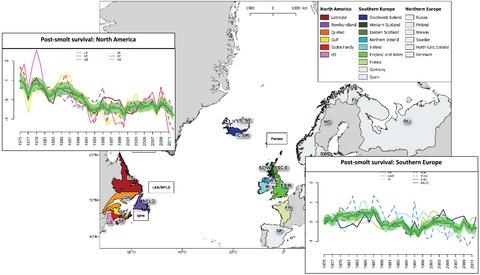当前位置:
X-MOL 学术
›
Glob. Change Biol.
›
论文详情
Our official English website, www.x-mol.net, welcomes your
feedback! (Note: you will need to create a separate account there.)
Spatial synchrony in the response of a long range migratory species (Salmo salar) to climate change in the North Atlantic Ocean.
Global Change Biology ( IF 10.8 ) Pub Date : 2019-11-08 , DOI: 10.1111/gcb.14913 Maxime Olmos 1, 2 , Mark R Payne 3 , Marie Nevoux 1, 2 , Etienne Prévost 2, 4 , Gérald Chaput 5 , Hubert Du Pontavice 1, 6 , Jérôme Guitton 1 , Timothy Sheehan 7 , Katherine Mills 8 , Etienne Rivot 1, 2
Global Change Biology ( IF 10.8 ) Pub Date : 2019-11-08 , DOI: 10.1111/gcb.14913 Maxime Olmos 1, 2 , Mark R Payne 3 , Marie Nevoux 1, 2 , Etienne Prévost 2, 4 , Gérald Chaput 5 , Hubert Du Pontavice 1, 6 , Jérôme Guitton 1 , Timothy Sheehan 7 , Katherine Mills 8 , Etienne Rivot 1, 2
Affiliation

|
A major challenge in understanding the response of populations to climate change is to separate the effects of local drivers acting independently on specific populations, from the effects of global drivers that impact multiple populations simultaneously and thereby synchronize their dynamics. We investigated the environmental drivers and the demographic mechanisms of the widespread decline in marine survival rates of Atlantic salmon (Salmo salar) over the last four decades. We developed a hierarchical Bayesian life cycle model to quantify the spatial synchrony in the marine survival of 13 large groups of populations (called stock units, SU) from two continental stock groups (CSG) in North America (NA) and Southern Europe (SE) over the period 1971-2014. We found strong coherence in the temporal variation in postsmolt marine survival among the 13 SU of NA and SE. A common North Atlantic trend explains 37% of the temporal variability of the survivals for the 13 SU and declines by a factor of 1.8 over the 1971-2014 time series. Synchrony in survival trends is stronger between SU within each CSG. The common trends at the scale of NA and SE capture 60% and 42% of the total variance of temporal variations, respectively. Temporal variations of the postsmolt survival are best explained by the temporal variations of sea surface temperature (SST, negative correlation) and net primary production indices (PP, positive correlation) encountered by salmon in common domains during their marine migration. Specifically, in the Labrador Sea/Grand Banks for populations from NA, 26% and 24% of variance is captured by SST and PP, respectively and in the Norwegian Sea for populations from SE, 21% and 12% of variance is captured by SST and PP, respectively. The findings support the hypothesis of a response of salmon populations to large climate-induced changes in the North Atlantic simultaneously impacting populations from distant continental habitats.
中文翻译:

北大西洋远距离迁徙物种(萨尔摩萨拉尔)对气候变化的响应的空间同步性。
理解人口对气候变化的反应的一个主要挑战是,将对特定人口独立行动的本地驱动者的影响,与同时影响多个人口的全球驱动者的影响分开,从而使他们的动态保持同步。我们调查了过去四十年中大西洋鲑(Salmo salar)海洋存活率普遍下降的环境驱动因素和人口统计学机制。我们开发了分级贝叶斯生命周期模型,以量化北美(NA)和南欧(SE)的两个大陆种群(CSG)中的13个大型种群(称为种群单位,SU)在海洋生存中的空间同步性在1971年至2014年期间。我们发现NA和SE的13个SU之间的蜕皮海洋生存的时间变化具有很强的连贯性。北大西洋共同的趋势解释了13 SU的生存时间变异性的37%,并且在1971-2014年的时间序列中下降了1.8倍。每个CSG中SU之间生存趋势的同步性更强。NA和SE尺度上的共同趋势分别捕获了时间变化总方差的60%和42%。鲑鱼在海洋迁移过程中在共同域遇到的海面温度(SST,负相关)和净初级生产指数(PP,正相关)的时间变化可以最好地解释后蜕皮存活的时间变化。具体来说,在拉布拉多海/大银行中,针对北美地区的人口,SST和PP分别捕获了26%和24%的方差,挪威海中SE种群的方差分别由SST和PP捕获了21%和12%的方差。这些发现支持以下假设:鲑鱼种群对北大西洋气候引起的巨大变化做出反应,同时又影响了来自遥远大陆生境的种群。
更新日期:2020-01-13
中文翻译:

北大西洋远距离迁徙物种(萨尔摩萨拉尔)对气候变化的响应的空间同步性。
理解人口对气候变化的反应的一个主要挑战是,将对特定人口独立行动的本地驱动者的影响,与同时影响多个人口的全球驱动者的影响分开,从而使他们的动态保持同步。我们调查了过去四十年中大西洋鲑(Salmo salar)海洋存活率普遍下降的环境驱动因素和人口统计学机制。我们开发了分级贝叶斯生命周期模型,以量化北美(NA)和南欧(SE)的两个大陆种群(CSG)中的13个大型种群(称为种群单位,SU)在海洋生存中的空间同步性在1971年至2014年期间。我们发现NA和SE的13个SU之间的蜕皮海洋生存的时间变化具有很强的连贯性。北大西洋共同的趋势解释了13 SU的生存时间变异性的37%,并且在1971-2014年的时间序列中下降了1.8倍。每个CSG中SU之间生存趋势的同步性更强。NA和SE尺度上的共同趋势分别捕获了时间变化总方差的60%和42%。鲑鱼在海洋迁移过程中在共同域遇到的海面温度(SST,负相关)和净初级生产指数(PP,正相关)的时间变化可以最好地解释后蜕皮存活的时间变化。具体来说,在拉布拉多海/大银行中,针对北美地区的人口,SST和PP分别捕获了26%和24%的方差,挪威海中SE种群的方差分别由SST和PP捕获了21%和12%的方差。这些发现支持以下假设:鲑鱼种群对北大西洋气候引起的巨大变化做出反应,同时又影响了来自遥远大陆生境的种群。











































 京公网安备 11010802027423号
京公网安备 11010802027423号